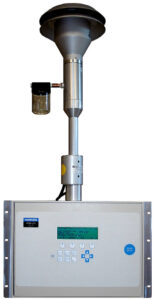Menu
- Mon - Sat 9.00am-6.00pm (Sunday Closed)

Menu
HORIBA - Continuous Ambient Air Quality Monitoring System
An Air Quality Monitoring Station (AQMS) is a system that measures metrological parameters such as wind speed, wind direction, rainfall, radiation, temperature, barometric pressure and ambient parameters. The AQMS also integrates a series of ambient analysers to monitor the concentration of air pollutants (such as SO2, NOx, CO, O3, THC, PM, etc.), continuously. HORIBA also provides mobile monitoring stations that can be used to monitor ambient conditions at multiple sites.HORIBA has more than 50 years’ experience providing ambient monitoring solutions, recognized around the world. HORIBA has supplied over 15,000 units with the major share in many regions. The monitoring station is tailor-made according to the customer’s request. HORIBA can provide several types of stations, calibration equipment and more to meet your challenging monitoring requirements. |

The measured data can be remotely monitored and exported in various formats to the local central authorities. The data can be published via the Internet for easy public access to raise awareness on current air pollution levels. This way, the public can prevent outdoor activities and reduce health impacts during eavy polluted days.
SO₂ concentration
Sulphur dioxide (SO2) is created when burning fossil fuels that contain sulphur, such as oil and coal. This gas is known to trigger asthma and is also a contributor to acid rain.

NOx concentrationNitrogen oxides (NOx) are mainly nitrogen monoxide (NO) and nitrogen dioxide (NO2). Nitrogen oxides (NOx) cause photochemical smog and acid rain, and nitrogen dioxide (NO2) in particular has a negative effect on the human respiratory system, including the throat, organs, and lungs. |

CO concentrationCarbon monoxide (CO) is mostly created when carbon compounds are not fully burned. When humans breathe it in, it attaches to their haemoglobin and stops it from carrying oxygen, causing various harmful effects. It is also believed to extend the lifespan of methane, which is a greenhouse gas. |

CO₂ concentrationCarbon dioxide (CO2) is considered a major cause of accelerated global warming, and in recent years, there have been discussions around the world about reducing its emissions. Monitoring indoor levels of carbon dioxide (CO2) has also gained attention as a way to maintain a healthy and productive work environment. |

O₃ concentration
Ozone (O3) is one of the main substances causing photochemical smog, which is formed when nitrogen oxides and hydrocarbons in the atmosphere are exposed to sunlight and undergo photochemical reactions. Photochemical smog causes eye pain, nausea, and headaches in humans.

NMHC, CH₄, THC concentration
Hydrocarbons are a general term for organic compounds consisting of carbon and hydrogen bonded together. Non-methane hydrocarbons (NMHC) are involved in the photochemical reactions of photochemical smog. Methane (CH4) is also a major greenhouse gas that accelerates global warming.

NH₃ Concentration
Ammonia (NH3) is a gas with a strong odor similar to urine, and each country has its own emission regulations because it is also a malodorous substance. It’s commonly released from livestock waste, fertilizers, and vehicles. When it reacts with nitrogen oxides (NOx) and sulphur oxides (SOx) in the atmosphere, it can contribute to the formation of PM2.5, which is a type of harmful air pollutant.

H₂S concentrationHydrogen sulphide (H2S) is a gas that has a distinct smell similar to that of rotten eggs. Each country has its own emission regulations because it is also a malodorous substance. When people come into contact with it, it can cause eye and respiratory irritation, headaches, and dizziness. This gas is also commonly found in geothermal and hot spring regions. |

Particulate matter related (PM2.5, PM10, SPM, elements, BP)
Suspended dust is composed of various substances, including inorganic and organic elements, and is classified into SPM, PM2.5, PM10, etc. according to particle size. The smaller the particle size, the more likely it is to penetrate deep into the body and cause respiratory diseases. Particulate matter also includes short-lived climate pollutants that contribute to global warming, of which black carbon is a typical example.
